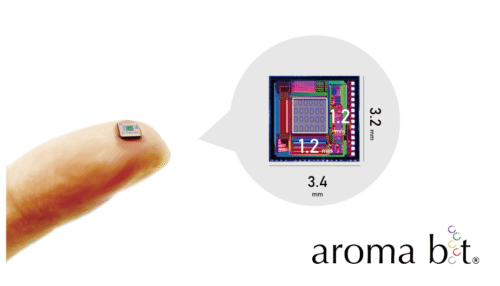The world’s smallest e-nose sensor features unmatched odour resolution and dense integration using cutting-edge CMOS technology.

Aroma Bit, Inc.,based in Chuo-ku, Tokyo, develops compact odour sensors and related innovative services. It recently unveiled a prototype of an e-nose-type odour imaging sensor. This prototype, built using CMOS semiconductors, claims to be the smallest in the world, featuring high integration and superior odour resolution.
The company has engineered a new odour imaging sensor chip utilising CMOS semiconductor technology. This chip, measuring 1.2 x 1.2 mm, includes integrated peripheral driver and A/D converter circuits. A key part of the development involved a demonstration test in maximising the number of odour-receptor membranes within the confined space of the chip’s sensor element area. These membranes were created using advanced printing technology from SIJ Technology, known for its capability to produce tiny droplets for ultra-fine dispensing at the micron level.
This development has led Aroma Bit to successfully establish a fundamental technology that accommodates 100 odour-receptor membranes within a mere 1.2mm x 1.2mm sensor element area. Consequently, this has created the world’s smallest e-nose type odour sensor to date, boasting the highest density sensor element array. With these advancements, Aroma Bit is poised to expedite its entry into markets that demand low-cost, high-volume applications, enhancing sensor integration across various devices.
Some of the key features of the e-nose type odor imaging sensor include:
- Chip Die Size: 3.2mm x 3.4mm
- Sensor Area Size: 1.2 mm x 1.2 mm
- Sensor Element: 240 x 240 Sensor Elements (57,600 Elements)
- Chip-embedded Circuitry: Sensor Driver Circuit / AD Converter Circuit
- Odour Receptor Membrane: 100 membranes deposited
Traditionally, gas chromatography and oxide semiconductor-type sensors have been used to measure odours. Gas chromatography can identify the specific components of an odour, whereas oxide semiconductor sensors measure the total concentration of odorants but cannot differentiate between individual odours. In contrast, the e-nose type odour sensor mimics the human nose’s ability to discern odours by creating a digital pattern of odours. This is achieved by depositing multiple odour receptor membranes with different chemical affinities onto various sensor elements.
For more information, click here.






